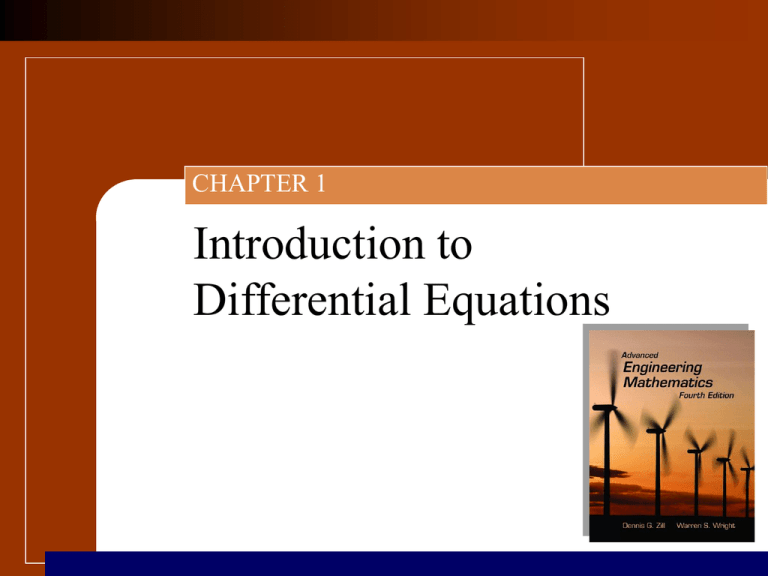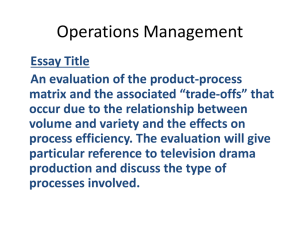Ch01 Introduction to Differential Equations
advertisement

CHAPTER 1 Introduction to Differential Equations Chapter Contents 1.1 Definitions and Terminology 1.2 Initial-Value Problems 1.3 Differential Equations as Mathematical Methods Lecturer: Prof. Hsin-Lung Wu Ch1_2 1.1 Definitions and Terminology Introduction: differential equations means that equations contain derivatives, eg: dy/dx = 0.2xy (1) Definition 1.1.1 Differential equation An equation contains the derivates of one or more dependent variables with respect to one or more independent variables (DE). Ordinary DE: An equation contains only ordinary derivates of one or more dependent variables of a single independent variable. eg: dy/dx + 5y = ex, (dx/dt) + (dy/dt) = 2x + y (2) Lecturer: Prof. Hsin-Lung Wu Ch1_3 Partial DE: An equation contains partial derivates of one or more dependent variables of tow or more independent variables. 2 2 2 2 u u u u u (3) 0, 2 x 2 y 2 x 2 t 2 t Notations: Leibniz notation dy/dx, d2y/ dx2 prime notation y’, y”, ….. subscript notation ux, uy, uxx, uyy, uxy , …. Order: highest order of derivatives second order 2 d y dx Lecturer: Prof. Hsin-Lung Wu first order 2 3 dx x 5 4y e dy Ch1_4 General form of n-th order ODE: F ( x, y, y ', , y (n) (4) )0 Normal form of (4) (5) n d y dx n f ( x, y, y ', , y ( n 1 ) ) eg: normal form of 4xy’ + y = x, is y’ = (x – y)/4x Linearity: An n-th order ODE is linear if F is linear in y, y’, y”, …, y(n). It means when (4) is linear, we have n n 1 d y d y dy (6) a ( x) a a ( x) a ( x) y g ( x) n dx n n 1 Lecturer: Prof. Hsin-Lung Wu dx n 1 1 dx 0 Ch1_5 The following cases are for n = 1 and n = 2 dy and a1 ( x) a0 ( x) y g ( x) dx 2 a2 ( x ) d y dx 2 a1 ( x) dy dx a0 ( x) y g ( x) (7) Two properties of a linear ODE: (1) y, y’, y”, … are of the first degree. (2) Coefficients a0, a1, …, are at most on x Nonlinear examples: (1 y ) y ' Lecturer: Prof. Hsin-Lung Wu sin y y 2 Ch1_6 Definition 1.1.2 Solution of an ODE Any function , defined on an interval I, possessing at least n derivatives that are continuous on I, when replaced into an n-th order ODE, reduces the equation into an identity, it said to be a solution of the equation on the interval. That is, a solution of (4) is a function possesses at least n derivatives and F(x, (x), ’(x), …, (n)(x)) = 0 for all x in I, where I is the interval is defined on. Lecturer: Prof. Hsin-Lung Wu Ch1_7 Example 1 Verification of a Solution Verify the indicated function is a solution of the given ODE on (-, ) x 1/2 4 y 2 y y 0 ; y xe (a) dy/dx = xy ; y = x /16 (b) Solution: 3 3 dy x x 4 (a) Left-hand side: dx Right-hand side: xy 1 / 2 then left = right (b) Left-hand side: 16 4 1/ 2 2 3 x4 x x x x 4 4 16 y 2 y y ( xe 2 e ) 2 ( xe e ) xe x x x x x 0 Right-hand side: 0 then left = right Lecturer: Prof. Hsin-Lung Wu Ch1_8 Note: y = 0 is also the solution of example 1, called trivial solution Lecturer: Prof. Hsin-Lung Wu Ch1_9 Example 2 Function vs. Solution y = 1/x, is the solution of xy’ + y = 0, however, this function is not differentiable at x = 0. So, the interval of definition I is (-, 0), (0, ). Fig 1.1.1 Ex 2 illustrates the difference between the function y = 1/x and the solution y = 1/x Lecturer: Prof. Hsin-Lung Wu Ch1_10 Explicit solution: dependent variable is expressed solely in terms of independent variable and constants. Eg: solution is y = (x). Definition 1.3 Implicit solution of an ODE G(x, y) = 0 is said to be an implicit solution of (4) on I, provided there exists at least one function y = (x) satisfying the relationship as well as the DE on I. Lecturer: Prof. Hsin-Lung Wu Ch1_11 Example 3 Verification of an Implicit Solution x2 + y2 = 25 is an implicit solution of dy/dx = −x/y on the interval -5 < x < 5. Since dx2/dx + dy2/dx = (d/dx)(25) then 2x + 2y(dy/dx) = 0 and dy/dx = -x/y solution curve is shown in Fig 1.1.2 Lecturer: Prof. Hsin-Lung Wu (8) Ch1_12 Fig 1.1.2 An Implicit solution and two explicit solutions in Ex 3 Lecturer: Prof. Hsin-Lung Wu Ch1_13 Families of solutions: A solution containing an arbitrary constant represents a set G(x, y) = 0 of solutions is called a one-parameter family of solutions. A set G(x, y, c1, c2, …, cn) = 0 of solutions is called a n-parameter family of solutions. Particular solution: A solution free of arbitrary parameters. eg: y = cx – x cos x is a solution of xy’ – y = x2 sin x on (-, ), y = x cos x is a particular solution according to c = 0. See Fig 1.1.3. Lecturer: Prof. Hsin-Lung Wu Ch1_14 Fig 1.1.3 Some solution of xy’-y=x2 sinx Lecturer: Prof. Hsin-Lung Wu Ch1_15 Example 4 Using Different Symbols x = c1cos 4t and x = c2 sin 4t are solutions of x + 16x = 0 we can easily verify that x = c1cos 4t + c2 sin 4t is also a solution. Lecturer: Prof. Hsin-Lung Wu Ch1_16 Example 5 A piecewise-Defined Solution We can verify y = cx4 is a solution of xy – 4y = 0 on (-, ). See Fig 1.1.4(a). The piecewise-defined function x , x 0 y 4 x , x0 4 is a particular solution where we choose c = −1 for x < 0 and c = 1 for x 0. See Fig 1.1.4(b). Lecturer: Prof. Hsin-Lung Wu Ch1_17 Fig 1.1.4 Some solution of xy’-4y=0 in Ex 5 Lecturer: Prof. Hsin-Lung Wu Ch1_18 Singular solution: A solution can not be obtained by particularly setting any parameters. y = (x2/4 + c)2 is the family solution of dy/dx = xy1/2 , however, y = 0 is a solution of the above DE. We cannot set any value of c to obtain the solution y = 0, so we call y = 0 is a singular solution. Lecturer: Prof. Hsin-Lung Wu Ch1_19 System of DEs: two or more equations involving of two or more unknown functions of a single independent variable. dx/dt = f(t, x, y) dy/dt = g(t, x, y) (9) Lecturer: Prof. Hsin-Lung Wu Ch1_20 1.2 Initial-value Problems Introduction A solution y(x) of a DE satisfies an initial condition. Example On some interval I containing xo, n d y ( n 1 ) solve: f ( x , y , y ' , , y ) n dx subject to: y ( x 0 ) y 0 , y ' ( x 0 ) y1 , , y ( n 1 ) ( x 0 ) y n 1 (1) This is called an Initial-Value Problem (IVP). y(xo) = yo , y(xo) = y1 , y ( n 1) ( x 0 ) y n 1 are called initial conditions. Lecturer: Prof. Hsin-Lung Wu Ch1_21 First and Second IVPs solve : dy f ( x, y ) dx subject (2) to : y ( x 0 ) y 0 and 2 solve : d y dx subject 2 f ( x, y, y ') (3) to : y ( x 0 ) y 0 , y ' ( x 0 ) y 1 are first and second order initial-value problems, respectively. See Fig 1.2.1 and 1.2.2. Lecturer: Prof. Hsin-Lung Wu Ch1_22 Lecturer: Prof. Hsin-Lung Wu Ch1_23 Example 1 First-Order IVPs We know y = cex is the solutions of y’ = y on (-, ). If y(0) = 3, then 3 = ce0 = c. Thus y = 3ex is a solution of this initial-value problem y’ = y, y(0) = 3. If we want a solution pass through (1, -2), that is y(1) = -2, -2 = ce, or c = -2e-1. The function y = -2ex-1 is a solution of the initial-value problem y’ = y, y(1) = -2. Lecturer: Prof. Hsin-Lung Wu Ch1_24 Example 2 Interval / of Definition of a Solution In Problem 6 of Exercise 2.2, we have the solution of y’ + 2xy2 = 0 is y = 1/(x2 + c). If we impose y(0) = -1, it gives c = -1. Consider the following distinctions. 1) As a function, the domain of y = 1/(x2 - 1) is the set of all real numbers except x = -1 and 1. See Fig 1.2.4(a). 2) As a solution, the intervals of definition are (-, 1), (-1, 1), (1, ) 3) As a initial-value problem, y(0) = -1, the interval of definition is (-1, 1). See Fig 1.2.4(b). Lecturer: Prof. Hsin-Lung Wu Ch1_25 Fig 1.2.4 Graph of the function and solution of IVP in Ex 2 Lecturer: Prof. Hsin-Lung Wu Ch1_26 Example 3 Second-Order IVP In Example 4 of Sec 1.1, we saw x = c1cos 4t + c2sin 4t is a solution of x + 16x = 0 Find a solution of the following IVP: x + 16x = 0, x(/2) = −2, x(/2) = 1 (4) Solution: Substitute x(/2) = − 2 into x = c1cos 4t + c2sin 4t, we find c1 = −2. In the same manner, from x(/2) = 1 we have c2 = ¼. Lecturer: Prof. Hsin-Lung Wu Ch1_27 Existence and Uniqueness: Does a solution of the IVP exist? If a solution exists, is it unique? Lecturer: Prof. Hsin-Lung Wu Ch1_28 Example 4 An IVP Can Have Several Solution Since y = x4/16 and y = 0 satisfy the DE dy/dx = xy1/2 , and also initial-value y(0) = 0, this DE has at least two solutions, See Fig 1.2.5. Lecturer: Prof. Hsin-Lung Wu Ch1_29 Theorem 1.2.1 Existence of a Unique Solution Let R be the region defined by a x b, c y d that contains the point (x0, y0) in its interior. If f(x, y) and f/y are continuous in R, then there exists some interval I0: (x0- h, x0 + h), h > 0, contained in [a, b] and a unique function y(x) defined on I0 that is a solution of the IVP (2). Lecturer: Prof. Hsin-Lung Wu Ch1_30 Fig 1.2.6 Rectangular region R The geometry of Theorem 1.2.1 shows in Fig 1.2.6. Lecturer: Prof. Hsin-Lung Wu Ch1_31 Example 5 Example 3 Revisited For the DE: dy/dx = xy1/2 , inspection of the functions f ( x , y ) xy 1/ 2 and f y x 2y 1/ 2 we find they are continuous in y > 0. From Theorem 1.2.1, we conclude that through any point (x0, y0), y0 > 0, there is some interval centered at x0 on which this DE has a unique solution. Lecturer: Prof. Hsin-Lung Wu Ch1_32 Interval of Existence / Uniqueness Suppose y(x) is a solution of IVP (2), the following sets may not be the same: the domain of y(x), the interval of definition of y(x) as a solution, the interval I0 of existence and uniqueness. Lecturer: Prof. Hsin-Lung Wu Ch1_33 1.3 DEs as Mathematical Models Introduction Mathematical models are mathematical descriptions of something. Level of resolution Make some reasonable assumptions about the system. The steps of modeling process are as following. Lecturer: Prof. Hsin-Lung Wu Ch1_34 Assumptions Express assumptions in terms of differential equations If necessary, alter assumptions or increase resolution of the model Check model Predictions with know facts Lecturer: Prof. Hsin-Lung Wu Mathematics formulation Solve the DEs Display model predictions, e.g., graphically Obtain solution Ch1_35 Population Dynamics If P(t) denotes the total population at time t, then dP/dt P or dP/dt = kP (1) where k is a constant of proportionality, and k > 0. Radioactive Decay If A(t) denotes the substance remaining at time t, then dA/dt A or dA/dt = kA (2) where k is a constant of proportionality, and k < 0. A single DE can serve as a mathematical model for many different phenomena. Lecturer: Prof. Hsin-Lung Wu Ch1_36 Newton’s Law of Cooling/Warming If T(t) denotes the temperature of a body at time t, Tm the temperature of surrounding medium, then dT/dt T - Tm or dT/dt = k(T - Tm) (3) where k is a constant of proportionality. Lecturer: Prof. Hsin-Lung Wu Ch1_37 Spread of a Disease If x(t) denotes the number of people who have got the disease and y(t) the number of people who have not yet, then dx/dt = kxy (4) where k is a constant of proportionality. From the above description, suppose a small community has a fixed population on n, If one inflected person is introduced into this community, we have x + y = n +1, and dx/dt = kx(n+1-x) (5) Lecturer: Prof. Hsin-Lung Wu Ch1_38 Chemical Reactions Inspect the following equation CH3Cl + NaOH CH3OH + NaCl Assume X is the amount of CH3OH, and are the amount of the first two chemicals, then the rate of formation is dx/dt = k( - x)( - x) (6) Lecturer: Prof. Hsin-Lung Wu Ch1_39 Mixtures See Fig 1.3.1. If A(t) denotes the amount of salt in the tank at time t, then dA/dt = (input rate) – (output rate) = Rin - Rout (7) We have Rin = 6 lb/min, Rout = A(t)/100 (lb/min), then dA/dt = 6 – A/100 or dA/dt + A/100 = 6 Lecturer: Prof. Hsin-Lung Wu (8) Ch1_40 Fig 1.3.1 Mixing tank Lecturer: Prof. Hsin-Lung Wu Ch1_41 Draining a Tank Referring to Fig 1.3.2 and from Torricelli’s Law, if V(t) denotes the volume of water in the tank at time t, dV dt Ah 2 gh (9) From (9), since we have V(t) = Awh, then dh dt Lecturer: Prof. Hsin-Lung Wu Ah Aw 2 gh (10) Ch1_42 Fig 1.3.2 Water draining from a tank Lecturer: Prof. Hsin-Lung Wu Ch1_43 Series Circuits Look at Fig 1.3.3. From Kirchhoff’s second law, we have 2 L d q dt 2 R dq dt 1 q E (t ) (11) C where q(t) is the charge and dq(t)/dt = i(t), which is the current. Lecturer: Prof. Hsin-Lung Wu Ch1_44 Fig 1.3.3 Current i(t) and charge q(t) are measured in amperes (A) and coulumbs (C) Lecturer: Prof. Hsin-Lung Wu Ch1_45 Falling Bodies Look at Fig1.22. From Newton’s law, we have 2 2 m d s dt mg 2 or d s dt 2 g (12) Initial value problem 2 d s dt 2 g, Lecturer: Prof. Hsin-Lung Wu s (0) s0 , s ' (0) v0 (13) Ch1_46 Fig 1.3.4 Position of rock measured from ground level Lecturer: Prof. Hsin-Lung Wu Ch1_47 Falling Bodies and Air Resistance From Fig 1.3.5. We have the DE m dv (14) mg kv dt and can be written as 2 m d s dt 2 mg k Lecturer: Prof. Hsin-Lung Wu ds dt 2 or m d s dt 2 k ds mg (15) dt Ch1_48 Fig 1.3.5 Falling body of mass m Lecturer: Prof. Hsin-Lung Wu Ch1_49 A Slipping Chain From Fig 1.3.6. We have L d x 2 32 dt 2 2 2 x Lecturer: Prof. Hsin-Lung Wu or d x dt 2 64 x0 (16) L Ch1_50 Fig 1.3.6 Chain slipping from frictionless peg Lecturer: Prof. Hsin-Lung Wu Ch1_51 Suspended Cables From Fig1.25. We have dy/dx = W/T1 Lecturer: Prof. Hsin-Lung Wu (17) Ch1_52 Fig 1.3.7 Cables suspended between vertical supports Lecturer: Prof. Hsin-Lung Wu Ch1_53 Fig 1.3.8 Element of cable Fig 1.3.8 explains the Element of cable. Lecturer: Prof. Hsin-Lung Wu Ch1_54 Evaluation One midterm 40% Final 40% Quiz & Homework 20% Lecturer: Prof. Hsin-Lung Wu Ch1_55 Some information Textbook: Advanced Engineering Mathematics 4th-ed by Zill and Wright Teaching Website: Please link 數位學苑 Lecturer: Prof. Hsin-Lung Wu Ch1_56





